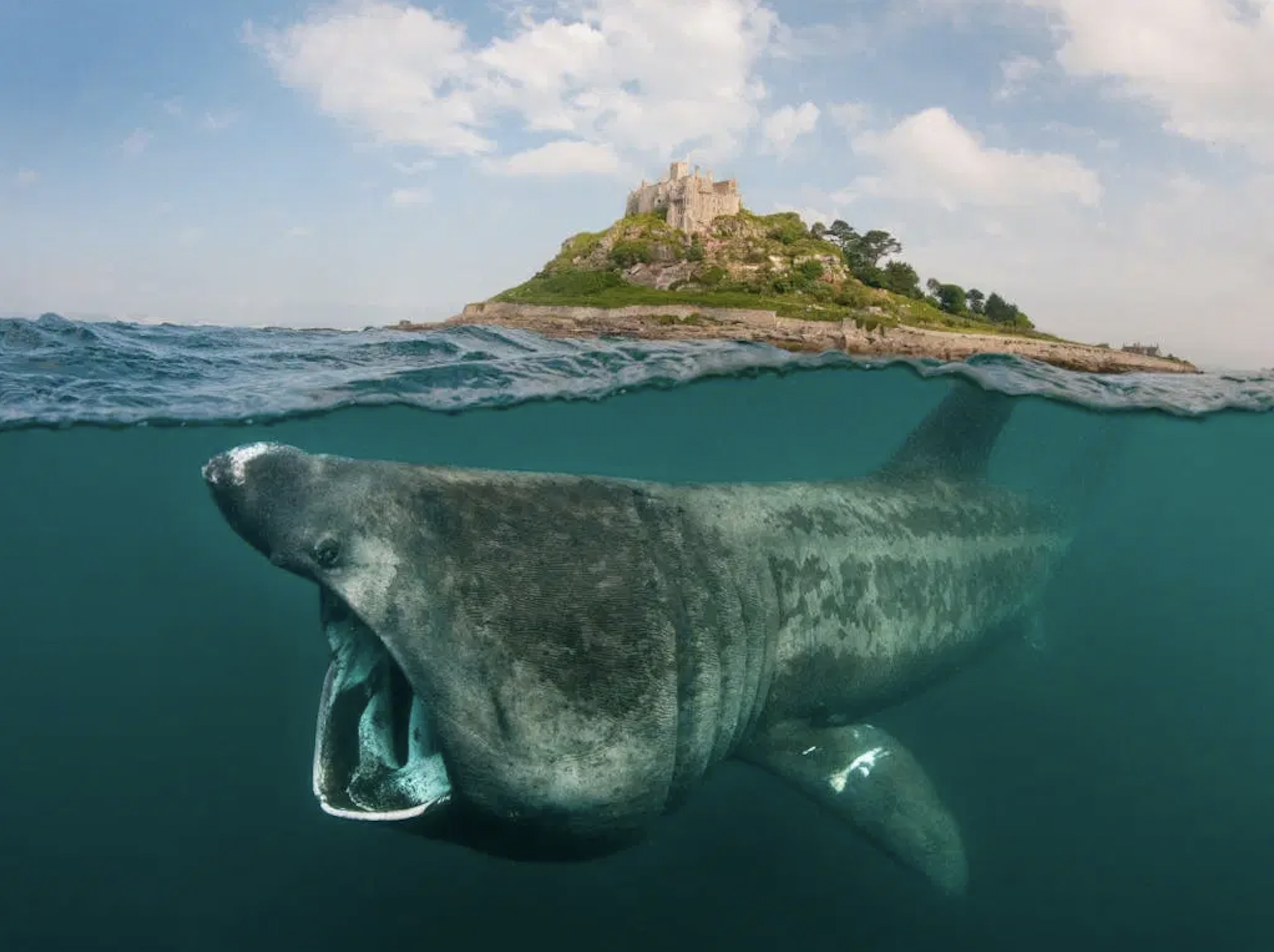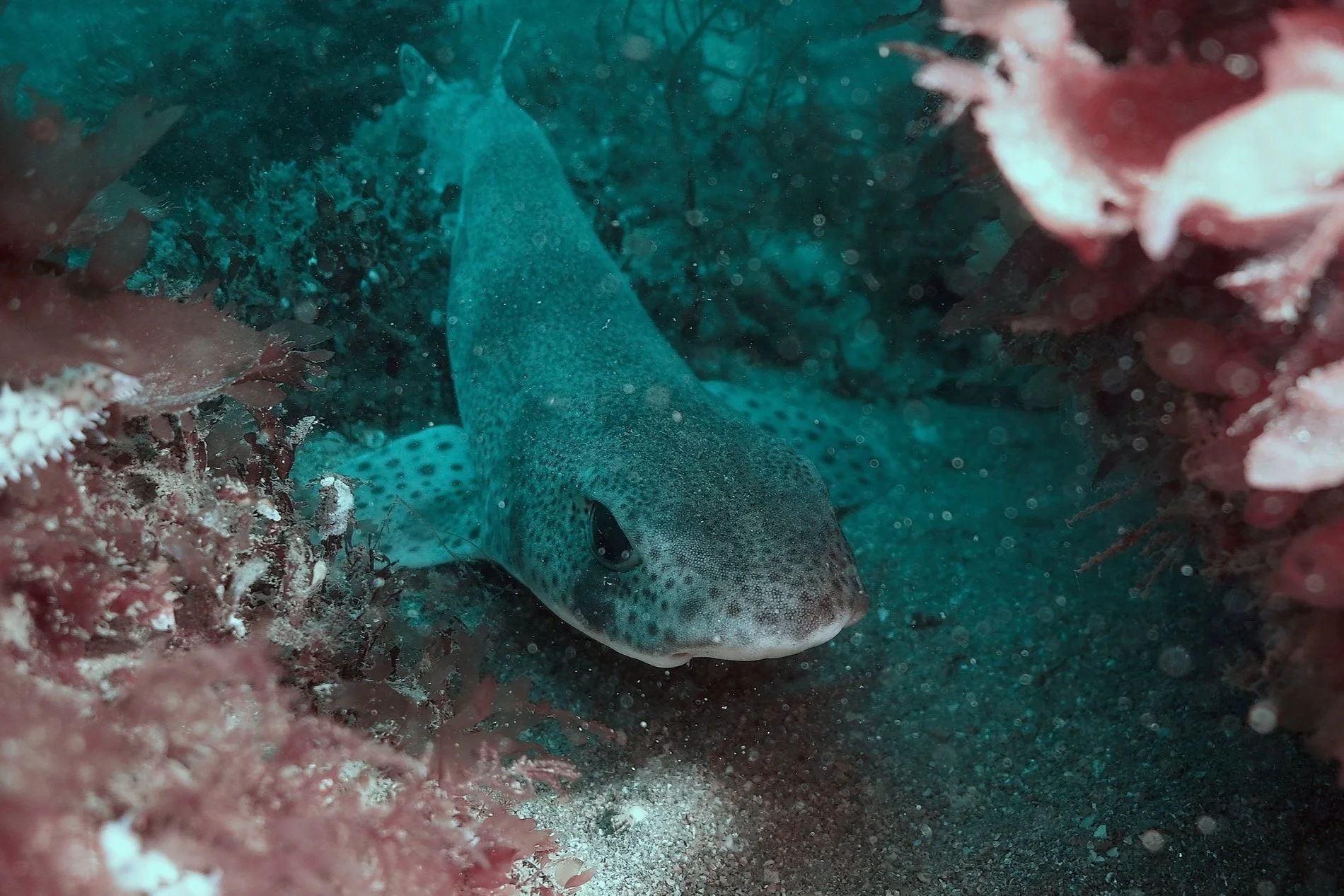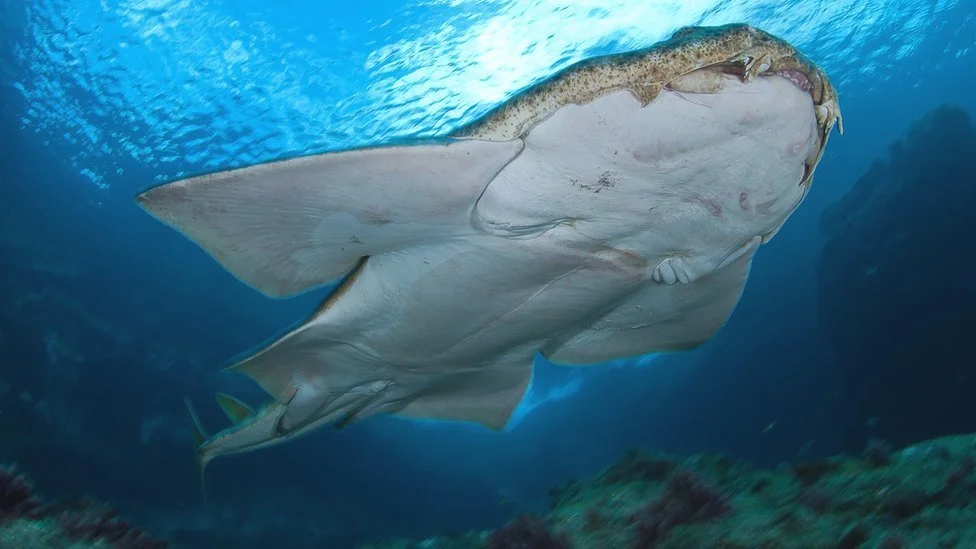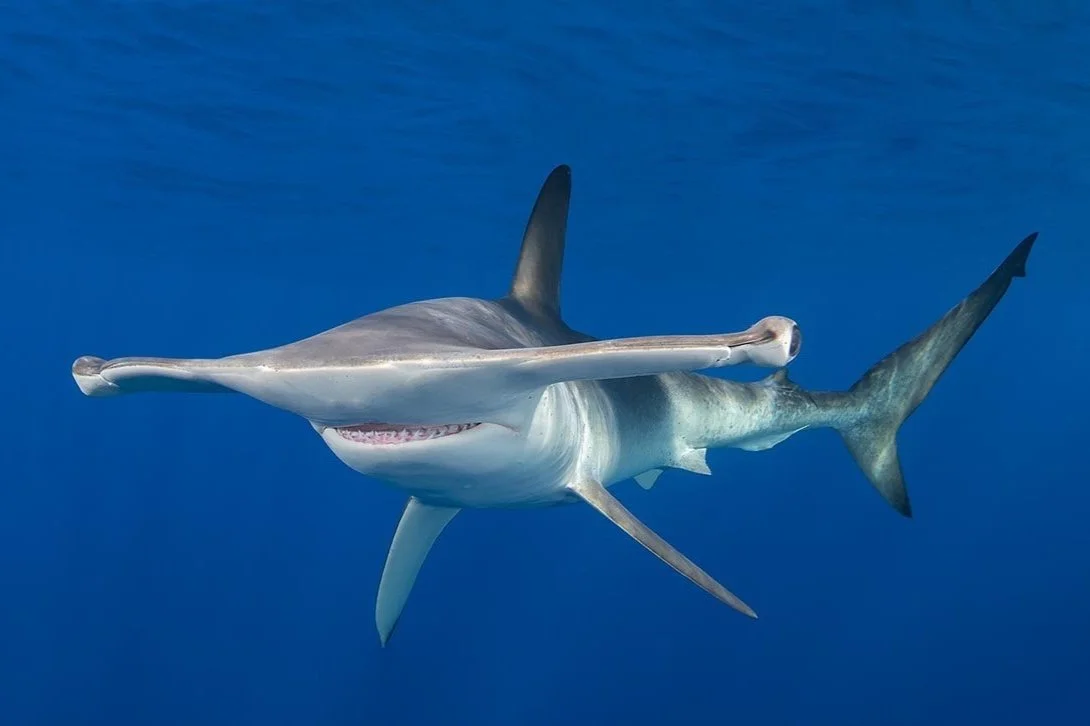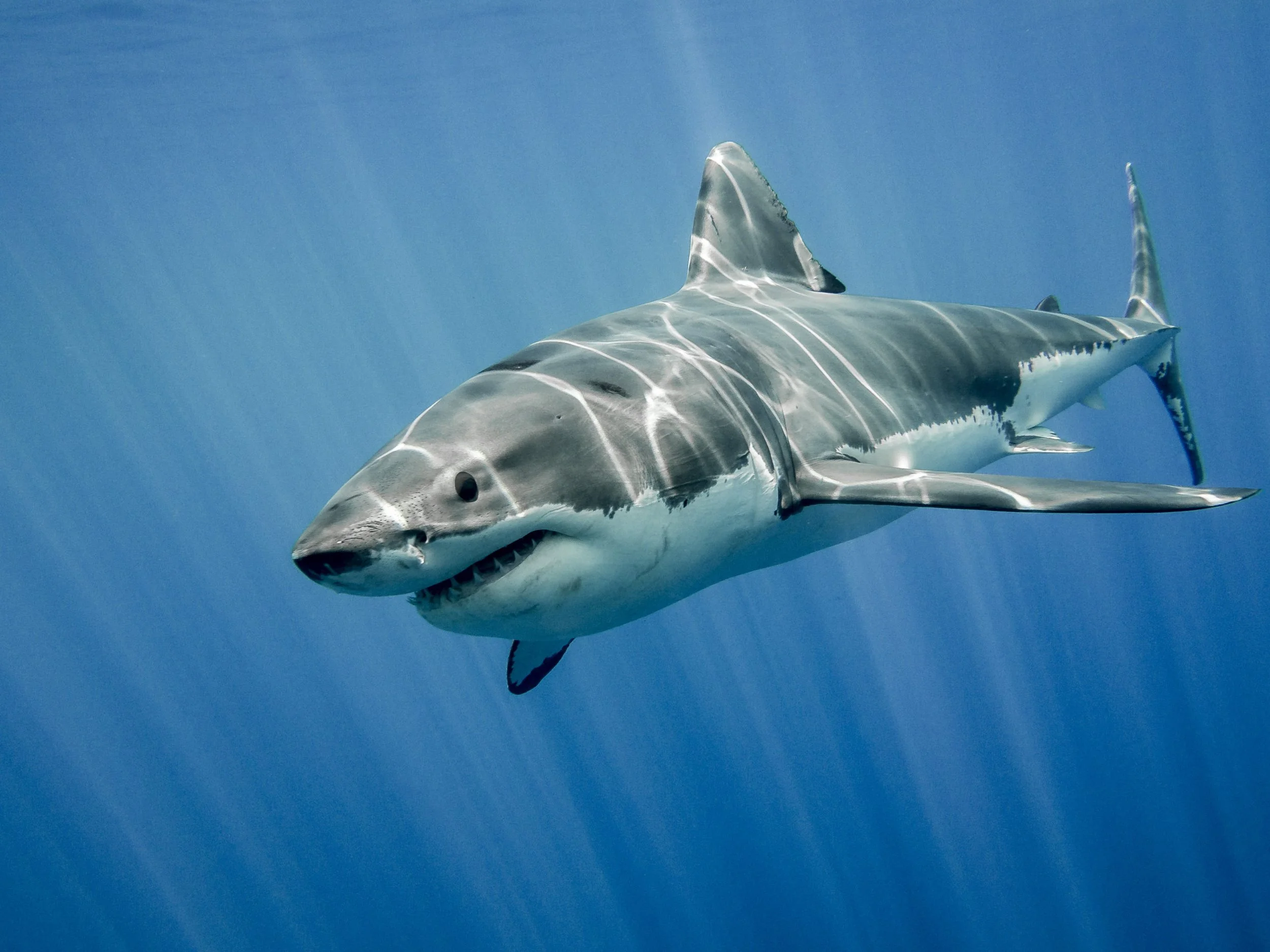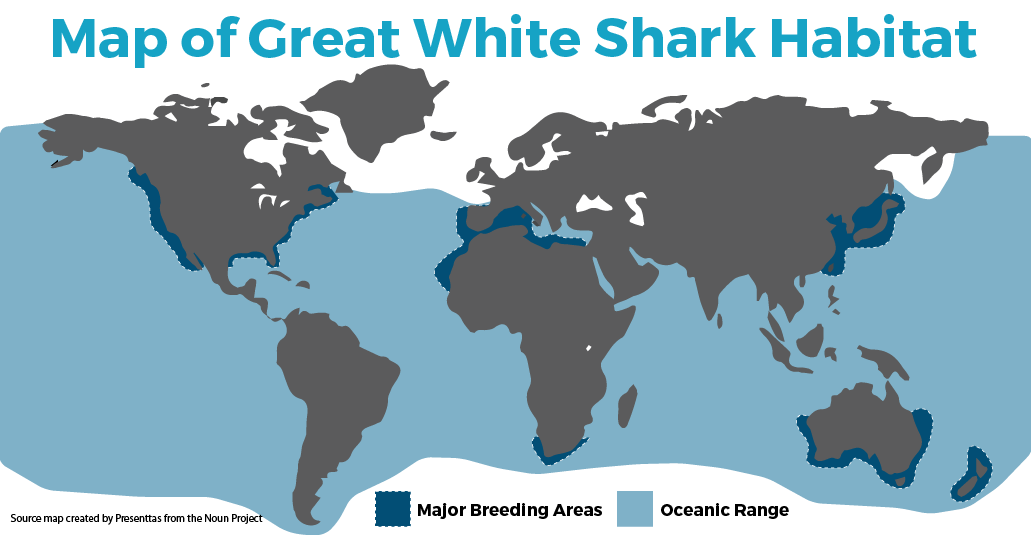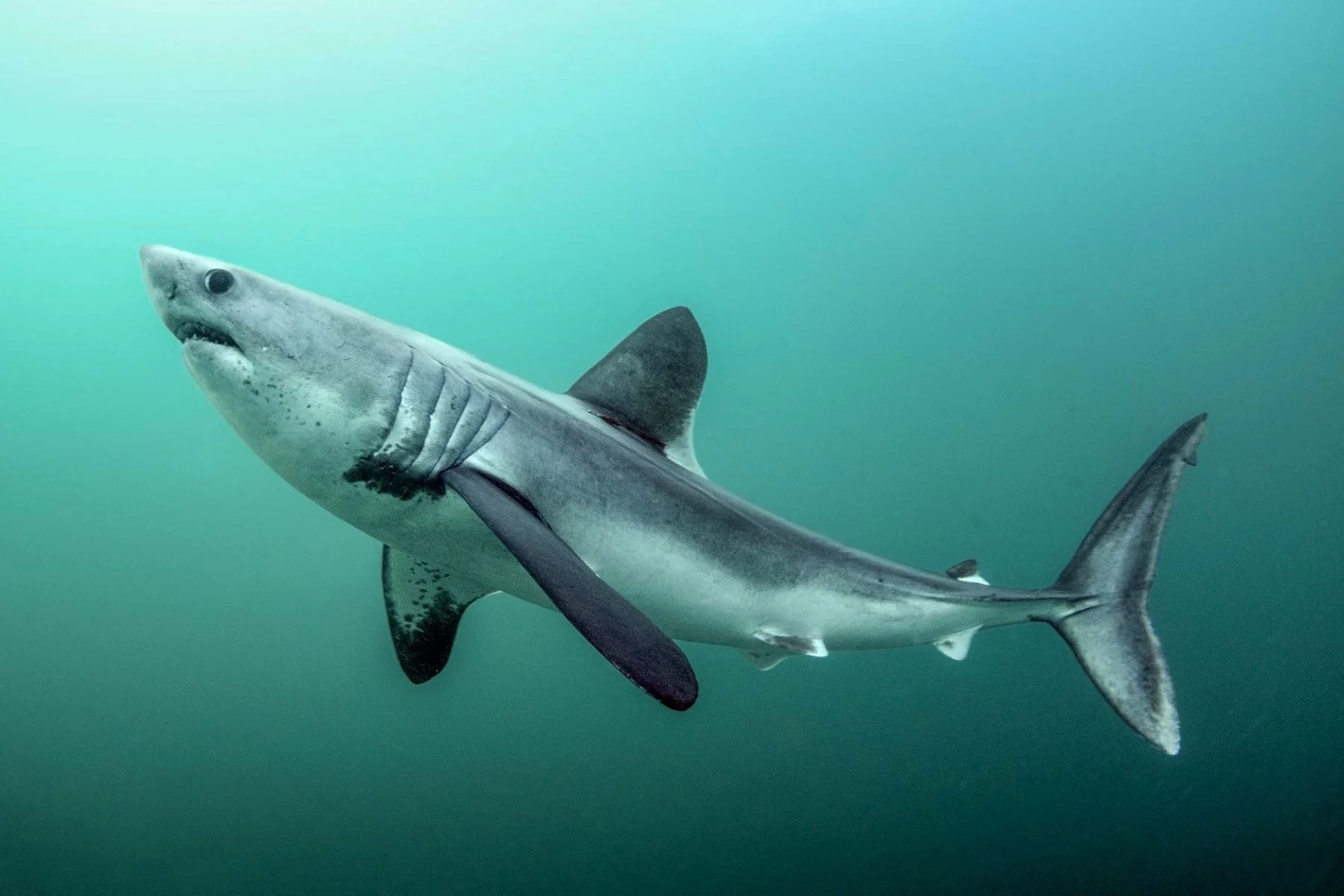Sharks Of The British Isles
From sheltered sea lochs & wild open waters, to seaweed beds & deepwater coral. The UK’s coasts and seas truly are amazing. But there’s more going on beneath our waves than one may think.
It’s actually a little known fact that the British Isles are home to some of the largest, fastest, rarest, and most migratory sharks in the world.
Sharks are essentially fish that have skeletons made of cartilage rather than bone, making them lighter and more buoyant in the water.
Over millions of years, sharks have evolved to develop extraordinary senses which is what helps them navigate the oceans as well as detect their prey.
Categorised as apex predators, sharks play a vital role in maintaining global ecosystems by controlling other species within the food chain, ultimately serving as an effective indicator for ocean health. Sharks not only help to do this by removing the sick, weak and weary, but by also maintaining a competitive balance between their own kind.
Like with many predators, migratory sharks continuously move their prey’s spatial habitat, which in turn alters their feeding strategy and diets. This, to some extent, makes sharks ultimately responsible for the cultivation and maintenance of almost all seagrass and coral reef systems.
The concerning decline of shark numbers has expectedly had a negative impact on the preservation of these essential environments, but also on commercial fisheries. By losing sharks from important ecosystems, larger predatory fish (such as groupers), have increased in abundance which feed on necessary reef nurturing herbivores. With less herbivores tending to reefs and seagrasses, the survival of these entire systems are universally threatened due to the uncontrolled overriding growth of macroalgae (or seaweeds).
With so many shark species now under threat, seeing a shark in UK waters should actually be a cause for celebration and not concern. Rest assured, out of over 500 shark species worldwide, only 300 of these (60% of species globally) have ever been involved in attacks on humans.
While some species of shark found in UK waters, such as the shortfin mako for example, are capable of inflicting a hugely powerful bite, unprovoked attacks on humans by sharks around the British Isles are considered extremely rare and almost unheard of. Most sharks are naturally wary of humans and will almost always choose to avoid any contact.
For more information on shark attacks, check out the international shark attack file here, courtesy of the Florida Museum.
Local Sharks
The British Isles overall are estimated to be visited by over 40 species of shark every year, of which at least 21 are generally considered as local sharks, resident here all year round.
Today, scientists consider over 50% of all UK sharks to be either near threatened, vulnerable, endangered or critically endangered as listed on the IUCN Red List of Threatened Species. This includes species such as the Angelshark, Porbeagle, and Basking sharks.
The Basking shark is listed as endangered and faces threats from entanglement and boat strikes, with Blue sharks classified as near threatened due to fisheries.
The critically endangered Angel Shark (pictured above) which is one step away from being classified as ‘extinct in the wild’, was once widespread throughout Europe’s seas, but they are now sadly extinct from much of their former range.
Historically, Angel sharks could be found from Scandinavia down to north-western Africa, including the Mediterranean and Black Seas, but the only place these majestic sharks are now regularly observed is in the Canary Islands. Over several decades, overfishing & bycatch of this species has catastrophically decimated these populations, leaving them now scattered and fragmented.
Although your probably unlikely to see a shark on a regular trip to the seaside, you may however find evidence of species such as the Small Spotted Catshark or Nursehound, as these sharks reproduce by laying eggs, and you can often find their empty cases washed up along the beach.
Below are a few of the most common local sharks found off our coasts all year round:
-
Catsharks are highly common around the UK and live close to the seabed ranging in depths from shallow waters down to approximately 100m deep.
Sometimes Catsharks wash up dead on our beaches after storms, but you're most likely to just come across one of their egg cases if nothing else. Shark egg cases (including ray and skate) are known as ‘mermaid's purses’ and are a good indicator of nearby breeding species. The egg case of Small Spotted Catshark measures around 5-7cm, and can be identified by its curly tendrils located on each corner.
The Small Spotted Catshark is a small shark named as a result of the dark spots and blotches covering its skin. Generally, all sharks have rough skin which are covered in hard dermal denticles (which literally means ‘tiny skin teeth’). If rubbed the wrong way, dermal denticles feel coarse like sandpaper, but strangely this provides the shark with effective chain-mail armour-like protection.
Catsharks are categorised as predators that feed on crabs, molluscs and other small fish. When threatened, they curl up into a round ‘donut shape’ which is claimed by experts to make them appear larger to their attackers and more difficult to eat.DISTRIBUTION:
Small Spotted Catsharks can be found all around UK coasts.
-
Nursehounds like to stay close to the sea floor, residing in rocky areas with plenty of algae. These sharks hunt at night, feeding on cephalopods (squid and octopus), crustaceans (crabs and shrimp), as well as other smaller fish and sharks.
During the day, Nursehounds hide away in holes and crevices within the rocks, with several sharks sometimes resting together in the same space.
The Nursehound is also known as the ‘Greater-Spotted Catshark’, ‘Bull Huss’, ‘Greater-Spotted Dogfish’, and ‘Rough Hound Shark’ – which is a lot of names for one species!DISTRIBUTION:
Nursehound Sharks can be found all around UK coasts.
-
Also known as the Spiny Dogfish, the Spurdog is a predator that feeds on bony fish, and sometimes even smaller sharks.
Spurdogs are a migratory species that spend the winter months down in deeper water, and the summer months in the warmer shallower coastal waters.
Spurdogs often travel in groups which makes them an easier target for fisheries. These sharks are typically slow to reproduce, often having 1 litter of pups every 2 or so years making it a challenge for them to recover from overfishing.DISTRIBUTION:
Spurdog sharks can be found in the Irish Sea and Northeast Atlantic
-
The Tope shark is a late to mature species with a triennial reproductive cycle (every 3 or so years).
Topes are globally targeted and are a bycatch component of gillnet, longline and trawl and hook-and-line fisheries. Where permitted, Tope is commonly retained for its meat and fins.
In the Southwest Atlantic, Southern Africa, and Australia, steep declines of Tope (up to 80%) have been reported.
In the Northeast Atlantic, a reduction of 76% over the past three generational lengths (79 years) has been recorded.
The Tope population in New Zealand has been reported as being reduced by 30–49%
In the Northeast Pacific, a dramatic decline in the 1940s has led to strict management measures resulting in an increase in abundance.
In Australia and the Northeast Atlantic, the remaining populations appear to have stabilised.
Overall, the population of Tope sharks has undergone a staggering global reduction of approximately 88% over the last 79 years.
Tagging studies have shown that Tope can travel huge distances and some individuals tagged in the UK have later been found as far away as the Canary Islands!
Tope sharks feed on a variety of fish species, but will also eat crustaceans and cephalopods if the opportunity arises. The beautiful Tope shark isn't exactly what you'd call a picky eater!
DISTRIBUTION:
Tope sharks can be found around all UK coasts, though they are more common in the South and West.
-
The Starry Smooth Hound shark is a common inshore and offshore shark found on the continental and insular shelves.
This species of shark is native to the Northeast Atlantic, found in areas like the British Isles and North Sea to Canary Islands, including the Mediterranean and Mauritania.
The Starry Smooth Hound shark is a small, long, thin shark that can grow up to a max length of 140 cm and a max published weight of 4.8 kg. On the top of this species of shark, around the fin and near the tail the Starry smooth-hound shark has scattered little white dots giving it its name.
The Starry smooth-hound shark prefers water with sandy and gravelly bottoms. It can be found at a depth range of 0 to 350m, and feeds primarily on crabs, lobsters and small bony fish.
DISTRIBUTION:
The Starry Smooth Hound shark can be found all around UK coasts.
-
Kitefin sharks are the world’s largest known bioluminescent shark, usually growing close to 6½ feet long.
It is thought that this species of shark are able to cleverly use their belly lights as they swim along to illuminate the seabed as they hunt for prey.
DISTRIBUTION:
Kitefin sharks are deep-water sharks, typically found on outer continental shelves and slopes at depths between 200 and 600 meters, but they have been found as shallow as 37 meters and as deep as 1800 meters.
While kitefin sharks are not uncommon in Scottish waters, they are rarely seen due to their deep-water habitat
Seasonal Visitors
Unlike Nursehounds and Catsharks, this next group of sharks are considered migratory or seasonal visitors, usually only seen in the warmer spring and summer months. If you're lucky enough during this time, you may be able to spot the world’s second largest fish, the magnificent Basking Shark.
Basking Shark season tends to be May to October, and there are a few hotspots around the British Isles where you'll have a good chance to see one. They are often spotted close to the surface enjoying either the warmth of the sun or feasting on plankton (thus the name basking shark).
Other seasonal visitors to the British Isles include the Blue Shark, Shortfin Mako and Porbeagle sharks. Blue sharks are highly migratory and can travel over 5,700 miles in a single trip. We are providing opportunity to see and swim with these beautiful sharks up close next year on one of our trips organised with our friends at In Deep Diving & Marine Services (Plymouth).
The Shortfin Mako is the fastest shark on record and can reach speeds of up to 30mph, enabling them to catch fast-swimming prey such as tuna and swordfish.
Below are some of the species of shark which visit the British Isles in the warmer months:
-
The Blue shark is an open-ocean (or pelagic) species that visits UK seas in the summer months.
Blue Sharks are identified as a slim torpedo shaped sharks with metallic blue colouration on top and white underneath. They have distinctively long pectoral (front) fins adding to their easy recognisability.
In the Atlantic, Blue sharks appear to follow a clockwise migratory route, following the Gulf Stream from the Caribbean to the UK, and returning there following the Atlantic North Equatorial Current.
Blue sharks are active predators and feed mainly on small fish and squid, although they have been known to eat seabirds and other small sharks too. They even feed on fish that live near the seabed and have been recorded at depths of up to 350m.
The largest Blue shark ever caught in UK seas weighed a whopping 256lbs (116kg) and measured over 9ft (2.74m).
DISTRIBUTION:
Blue sharks can be spotted around 10 miles off the South West coast of England, generally in the summer months only.
-
Arguably the most dangerous shark in the UK, the Mako can grow up to an amazing 12 feet in length.
While attacks are relatively rare, the International Shark Attack File records 10 unprovoked Mako attacks on humans between 1980 and 2024.
Shortfin Mako sharks are usually found off the coasts of Africa, South America, the Caribbean, Australia, India and Pakistan.
In September 2013 boat anglers reported seeing mako sharks off the coast of Cornwall, while in December 2014 a 10ft Mako Shark washed up on a Welsh beach.
DISTRIBUTION:
In Europe, Short Fin Mako sharks are considered at the limit of their distribution but are certainly confirmed as being present all around the coasts of the British Isles during the warmer months, but mainly southern and western England, parts of Wales and Ireland.
-
The Basking Shark is the second largest fish in our oceans - its relative the Whale shark being the biggest.
Despite their size, Basking sharks only feed on zooplankton which they filter out of the water, swimming slowly back and forth with their enormous mouths wide open.
Basking sharks are most commonly seen in the summer, when they arrive in British waters. Courtship behaviour has been seen off the Isle of Man - so perhaps they arrive here to breed!
DISTRIBUTION:
For the best chance of spotting Basking sharks, visit either Cornwall, the Isle of Man or the Inner Hebrides where they can generally be seen from cliffs, but your best chance is to take a boat trip with a reputable wildlife watching company.
-
The Angelshark looks as if it’s half way between a shark and a ray, and they only grow to about 2.4 metres long.
Angelsharks have large, billowing fins on their sides, and two small dorsal fins perched atop the tail, looking a bit like they’ve been compressed. It is expectedly advantageous for them to be as flat as possible as these creatures spend most of their time buried in the sand on the sea bottom.
The Angelshark used to be referred to as “monkfish.” However, this common name also applies to Lophius piscatorius, a flatfish that feeds in a similar way to an Angelshark, leading to confusion.
The monkfish is a flat-bodied deep-water fish that uses a lure-like protrusion to attract fish near to its mouth. It then ambushes prey by lunge-feeding, in a similar way to Angelsharks. The sharks however do not use a lure, and are not a bony fish.
Once common in the British Isles, the Mediterranean, the Black Sea, and the North East Atlantic, this species is now classified as regionally extinct in many of the areas it once thrived in, as well as critically endangered in the UK.
As a bottom-dweller, usually, the only part of it you will see are its two observant eyes poking out of where it is buried in the sand or mud. It is found in water up to 500 metres deep.
Angelsharks are often found swimming the most at night, free hunting or searching for new sandy areas to camouflage in.
DISTRIBUTION:
Angelsharks in the UK are primarily found in Welsh waters, with hotspots in areas like North Cardigan Bay, Tremadog Bay, and Carmarthen Bay.
-
This large shark is usually found in deeper water, where it hunts a variety of smaller fish including mackerel, whiting and herring, as well as octopus, squid and cuttlefish.
They are strong swimmers and tagging studies have shown that they can travel huge distances. One porbeagle shark tagged in Irish waters was later found as far away as Newfoundland in Canada!
Porbeagle sharks are endothermic, which means they can maintain a higher body temperature and keep themselves warmer than the surrounding water. This is a big advantage for them as it allows them to live and hunt in colder seas than many other sharks.DISTRIBUTION:
Found around all UK coasts, specifically in June to October, as well as in temperate waters world-wide (excluding the North Pacific).
Occasional Visitors
While some species of shark like the Catshark contribute to our amazing marine biodiversity all year round, others like the aforementioned Basking shark are only one of many seasonal summer visitors to our ever changing seas, but this isn’t the full extent of our infamous finned friends.
When it comes to sharks, the British Isles also has an impressive list of occasional visitors, ranging from unassuming pelagic’s and deep water dwellers, to one species in particular which is considered as having the longest lifespan of any known invertebrate, possibly living to an impressive 500 years old!
There are at least 11 known deepwater shark species found within the British Isles, which includes the Portuguese Dogfish, Black Dogfish, Kitefin Shark and Gulper Shark, but the Greenland shark is most likely to be the shark which most people are familiar with.
Below are some of the species of shark which rarely seen but known to occasionally visit the British Isles. This classification also covers sharks which have been found deceased off our shores indicating a presence at some time:
-
The Smooth Hammerhead shark has a broad distribution worldwide but prefers temperate waters. They have been recorded in British waters but sightings overall are considered rare.
Younger sharks may gather together in huge schools (a shiver) to migrate, travelling south in winter and north in summer.
With older sharks preferring to migrate in smaller groups. Males sexually mature around 2.1m. While females mature later at 2.7m, giving birth to litters of 20-50 pups.
Smooth Hammerheads are thought to live to around 20 years old.
The biggest threat facing Smooth Hammerheads comes from overfishing. While there's no target fishery for this species, they're highly-prized for their fins. So, if captured as bycatch they’re often retained throughout much of their geographic range, although retention of hammerhead sharks is banned in Atlantic high-seas fisheries.DISTRIBUTION:
Smooth Hammerhead sharks are occasional visitors to UK waters, usually in the pursuit of plankton blooms, and can be seen around Cornwall and the Isle of Man. While they are rarely seen, they have been recorded in various other locations around the UK, but mainly around the south and southwest.
-
This deep sea shark doesn’t look like your typical shark, but that’s because it’s perfectly adapted to life in the abyss.
Named ‘Frilled’ because of the fluffy appearance of its gills, this shark has six slits on either side of their head.
Frilled sharks are thought to hunt along the seabed using specialist honed senses to locate their prey. When they eventually do, they lunge at them like a snake.
With over 200 pin-sharp teeth designed to trap prey, the victim stands little to no chance of escape. Not only that but the Frilled shark can even swallow prey half its own size…whole!
With new technology allowing us to go deeper and for longer than ever before, we are still making discoveries about this lesser known shark.
DISTRIBUTION:
Frilled sharks are primarily found in the open ocean's deep waters, ranging from the outer continental shelves to the upper continental slopes.
In the UK, they are most commonly observed in the northern waters, specifically the Faroe-Shetland Channel and the Rockall Trough.
-
The Greenland shark is believed to be the longest living vertebrate, with some living up to 500 years. They are also known as "‘Gurry Sharks”, “Grey Sharks” and "Sleeper sharks". They are a rare but confirmed species in UK waters.
Greenland shark meat is toxic to mammals due to its high levels of Trimethylamine N-oxide, although a treated form of it is eaten in Iceland as a delicacy.
While Greenland sharks are known to frequent the deep, cold waters around the UK, they are rarely ever encountered by humans. One notable incident from 2022 involved a 13-foot female juvenile Greenland shark that stranded itself on a beach in Cornwall. It was later found to have died from meningitis.
DISTRIBUTION:
Greenland sharks are known to frequent the waters around Scotland and further north. While not common, they have been found off the coast of Cornwall following the notable stranding in Penzance in 2022.
-
The Thresher shark (also known as Common Thresher) spends most of its time in the deep waters of the open sea, rarely straying into coastal areas.
Threshers are described as a large shark, with the classic shark shaped torpedo like body, a large dorsal fin and large pectoral fins. The thresher shark is easily identified from other sharks by the long upper lobe of the tail, which can be as long as the shark's body itself.
To survive in colder waters, such as here in the UK, they have evolved to be endothermic. This means that they can keep their body temperature higher than the temperature of the surrounding water. They do this through a specialised heat exchange system, which allows them to conserve heat produced through internal body mechanisms such as metabolism or muscle shivering.
DISTRIBUTION:
Thresher sharks are summer visitors to UK waters, typically found in the south and southwest from June to October. They are known to frequent deeper offshore waters and are often associated with areas where shoaling fish like mackerel and herring are abundant.
-
2023 in particular was a bizarre year for sharks in Britain.
In March of that year, a Smalltooth Sandtiger shark was spotted alive off the coast of Hampshire where it was pulled back out to sea by a swimmer, hoping it would return safely to deeper water. Sadly, it was later found dead on the beach and it sparked a race to secure it for science.
But that was only the start of the Sandtiger Shark affair. In April, a massive, 13ft specimen was found on a beach in Co Wexford, Ireland. Another appeared a month later, floating dead in Lyme Bay, off Dorset.
Scientists are still wondering why this trio of rare sharks showed up so near each other. It could be that warming seas are drawing the species further north, but why these ones died still remains a mystery.
DISTRIBUTION:
Smalltooth Sandtiger sharks have a cosmopolitan distribution, meaning they are found in many parts of the world's warm temperate and tropical seas. They are typically found on or near the bottom of continental and insular shelves and upper slopes, often in rocky, boulder-strewn areas.
While generally considered a deepwater species, they have been observed in shallower waters as well.
This species of shark are rarely, if ever, seen in this part of the world, but are subsequently now considered an ‘occasional visitor’.
For further reading on local, seasonal and occasional visiting sharks to the British Isles, The Shark Trust have compiled an introductory guide to Sharks and Rays which can be downloaded free here.
Great White Sharks in the British Isles
With temperate waters and plenty of seals, British seas yield perfect conditions for White sharks. But is the most famous and iconic of all shark species found here?
The truth is… nobody really knows.
Some hypothesise that the White shark may not have actually discovered our shores yet, while others have argued that their migration is simply not worth the energy it would take to get here. There are however some experts who believe that these sharks, are in fact, already here but remain hidden… apart from the occasional speculative sighting of course.
Great White sharks are members of the ‘Lamindae’ family of mackerel sharks which are considered fast swimming predatory fish. Great Whites, just like the Porbeagle (and ironically humans) are endothermic, meaning they can maintain a body temperature higher than the surrounding water in certain parts of their body.
Sharks (by majority) are usually ectothermic (cold-blooded), but some, like those in the Lamnidae family, exhibit regional endothermy, meaning they are able to travel in waters where the temperatures can range anywhere between 2.7°C to 27°C, which pretty much includes anywhere other than the polar regions.
Generally, the waters that Great White shark often tends to inhabit are found to be around the 16° Celsius mark, which is right in the middle of the mean water temperature that the UK experiences during it’s summer and autumnal months, making our seas an ideal habitat for this species.
Sightings of Great White’s have only really been reported in the UK in the last 60 years, ranging from the first recorded sighting in Falmouth in 1965, to Lewis in the Outer Hebrides in 2016.
The Porbeagle shark (pictured), is often mistaken for the Great White leading to numerous erroneous sightings and false claims of white sharks in UK waters. Porbeagle sharks are actually half the size of the much larger Great White, but share many similarities in that they are also members of the Lamnidae family of sharks, thus making them one of the Great White’s closest living relatives.
Over the past two decades, Richard Pierce, renowned shark expert, activist, writer, broadcaster and wildlife conservationist has led numerous investigations into reported sightings of Great White sharks around the British Isles.
Out of an astounding documented 100 or so cases, only a mere 12 sightings have actually remained credible, but it’s also argued that some of these reports may have concerned the same shark, which could further reduce the number down to 7.
The mystery of White sharks and the British Isles has intrigued Plymouth MRes Marine Biology student Max Kimble, who in December 2022 published his BSc (Hons) Ocean Science and Marine Conservation paper on Great White sharks in Britain.
The results of Max's dissertation, 'An investigation into the absence of the great white shark (Carcharodon carcharias) from British waters', showed that British waters display ‘near perfect’ habitat suitability for both sexes all year-round, thus indicating that there is no environmental reasoning for the White sharks apparent absence.
Despite this, Max believes an answer may have been found within their behaviour.
“When comparing the tagged shark’s migrations with what we know about their migratory habits, it was concluded that if a great white were to visit British waters it would most likely be a male from the Mediterranean population swimming at depth, therefore explaining why despite perfect conditions, they have not been confirmed in these waters due to their prolonged time at depth.”
Alternatively, Max also puts forward a counter hypothesis:
“indicating that British waters are suited to the northwest Atlantic population and that the Mediterranean white sharks have different environmental preferences due to their geographic isolation and potential speciation.”
Marine Biology MRes graduate Max Kimble’s dissertation can be downloaded here:
Kimble, Max Harry (2022) "An investigation into the absence of the great white shark (Carcharodon carcharias) from British waters," The Plymouth Student Scientist: Vol. 15: Iss. 2, Article 5.
DOI: https://doi.org/10.24382/2bpv-ay41
Available at: https://pearl.plymouth.ac.uk/tpss/vol15/iss2/5


